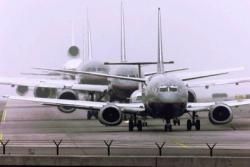Wait A Minute... GA Advocacy Group AGREES With ATA???
On Monday, the Aircraft Owners and Pilots
Association said the Federal Aviation Administration is
jumping too far, too soon with its plan to reduce airline delays
with congestion pricing.
"Congestion pricing should be the FAA’s last resort, not
its first," said AOPA President Phil Boyer. "The agency’s
proposal does nothing to improve the national air transportation
system and could in fact hurt general aviation’s access to
airport."
Somewhat unusually, AOPA's stand on congestion pricing brings
the general aviation advocacy group into agreement with the Air
Transport Association, trade and lobbying group for the nation's
airlines, on an issue involving user fees. While arguing against
the idea of congestion pricing, ATA has been a vocal proponent for
such fees against pilots of general aviation aircraft... saying
smaller planes need to pay their "fair share" for use of the
national airspace system.
That mirrors the logic FAA cites in calling for implementation
of congestion pricing. As ANN has reported, both DOT
and FAA have proposed airlines pay higher fees to land during peak
times at the nation's busiest airports, stating such fees would
convince carriers to more evenly spread out arrival and departure
times throughout the day.
There's little to prevent the government from extending such
congestion pricing to non-airline aircraft, however... and AOPA
notes a proactive solution on the part of airport users would be
the preferred way to go, anyway, as opposed to imposed fees.
In its formal comments and in previous communications with the
FAA and the US Department of Transportation, AOPA has offered
specific suggestions for ways to reduce delays. Some of those
suggestions include:
- Align schedules with capacity benchmarks;
- Implement changes in air traffic control procedures;
- Educate the travelling public;
- Ensure adequate air traffic control staffing;
- Add more runways to existing airports; and
- Mandate key technologies for landing at congested
airports.
 Although delays ripple
through the system, AOPA notes, they are generally caused by
problems at specific airports. The MITRE Corporation, which does
research and development work for the FAA, determined seven air
carrier airports alone are responsible for 72% of delays in the
system. General aviation accounts for only 2.1% of the traffic at
those seven airports.
Although delays ripple
through the system, AOPA notes, they are generally caused by
problems at specific airports. The MITRE Corporation, which does
research and development work for the FAA, determined seven air
carrier airports alone are responsible for 72% of delays in the
system. General aviation accounts for only 2.1% of the traffic at
those seven airports.
An aviation rulemaking committee established by the Department
of Transportation to develop ways to reduce congestion in the New
York City did not endorse congestion pricing and in fact made clear
in its report that the concept was opposed by the majority of the
aviation community.
"The possibility that this policy could expand to reliever and
other general aviation airports is alarming," said Andy Cebula,
AOPA’s executive vice president of government affairs.
"Airports that don’t even have airline service may see
DOT’s new emphasis on congestion pricing as a green light to
to start charging our members more to use their facilities, even
though such tactics at those airports would have absolutely no
effect on systemwide delays."
Discouraging or limiting general aviation access to airports is
an unsatisfactory management strategy. AOPA believe the Department
of Transportation should scrap plans for congestion pricing and
pursue alternative solutions that have been offered by the aviation
rulemaking committee and others in the aviation industry.
 ANN's Daily Aero-Term (04.26.24): DETRESFA (Distress Phrase)
ANN's Daily Aero-Term (04.26.24): DETRESFA (Distress Phrase) ANN's Daily Aero-Linx (04.26.24)
ANN's Daily Aero-Linx (04.26.24) Airborne 04.22.24: Rotor X Worsens, Airport Fees 4 FNB?, USMC Drone Pilot
Airborne 04.22.24: Rotor X Worsens, Airport Fees 4 FNB?, USMC Drone Pilot Airborne 04.24.24: INTEGRAL E, Elixir USA, M700 RVSM
Airborne 04.24.24: INTEGRAL E, Elixir USA, M700 RVSM Airborne-NextGen 04.23.24: UAVOS UVH 170, magni650 Engine, World eVTOL Directory
Airborne-NextGen 04.23.24: UAVOS UVH 170, magni650 Engine, World eVTOL Directory



